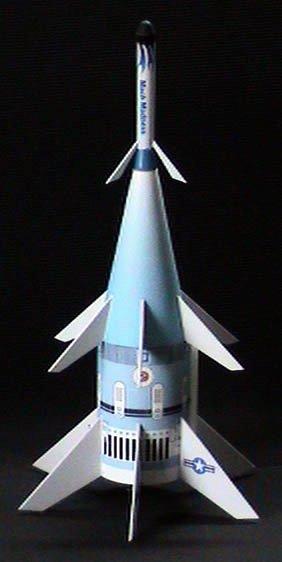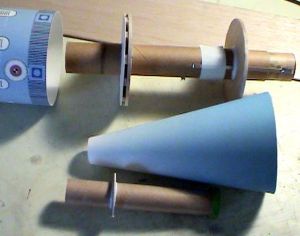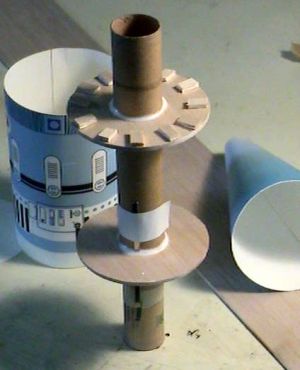Scratch Mach Madness Original Design / Scratch Built
Scratch - Mach Madness {Scratch}
Contributed by Jeff Lane
| Manufacturer: | Scratch |

Brief:
"Mach 1-2-3" Virtual Rocket Contest entry built as a single-stage
flyer.
Construction:
The rocket consists of 1 Estes Mosquito nose cone, 1 BT-5 tube, 3/32"
balsa fin stock (used for 15 fins), 1 balsa 5-20 transition, 1 BT20 tube, 1
Estes 20-55 centering ring, 1 custom bristol transition, 1 custom bristol body
tube with printed graphics, 1/8" balsa centering rings, 1 BT-50 tube, 1
engine hook, 1 engine block, 1 solid paper 20-50 centering ring, 12"
parachute, and 1/8" shock cord.
This is for experienced modelers. It has 15 fins, which requires great patience. The preprinted bristol paper (I got it at an art supply store) forms the lower body tube and the midsection transition. It is astoundingly quick to assemble and looks great.
The parachute fits inside the shroud and requires careful prep to ensure proper deployment. The shock cord must be packed first to pull the parachute out.
The large mid-rocket transition/bulkhead solution was a challenge to design and build. At the front of the transition, it seats on the front of the BT-20 and a 20-55 centering ring about 1.5" from the front of the BT-20. At the widest point where it joins with the 3" body, the ideal piece would have been a solid balsa coupler with half of it fitting inside the 3" first stage body tube, and half (conical shaped) fitting up into the transition. Instead of doing that, I designed the first stage motor mount so the bulkhead is at the leading edge of the 3" body tube with scrap balsa offsetting a slightly smaller diameter bristol paper centering ring. This seats the transition nicely, provides needed fore-aft rigidity to the bristol and is a very lightweight solution.
 If I built
it again, I might extend the BT-50 engine tube all the way to a balsa 50-5
transition so the parachute would eject just aft of the "sustainer".
The tiny, small footprint sustainer fins would then be subject to more violence
from the shock cord and parachute but deployment may be more reliable.
If I built
it again, I might extend the BT-50 engine tube all the way to a balsa 50-5
transition so the parachute would eject just aft of the "sustainer".
The tiny, small footprint sustainer fins would then be subject to more violence
from the shock cord and parachute but deployment may be more reliable.
The bristol body tube is not quite as rigid as a regular body tube, which is good and bad. When I dropped the finished product on the floor, there was enough "give" so that none of the 15 fins broke. However, you do have to be extra careful not to crush it while installing an engine or during assembly.

Finishing:
The fins were sealed and filled with one coat of dope then all of the remaining
grain was eliminated with one coat of automotive high-build primer from
Autozone. The only painting was the black nose cone, white on the sustainer and
fins, and blue on the small balsa transition. The waterslide decal material
from lazertran.com prints on an inkjet printer and dries in an hour. Then the
ink doesn't come off in the water even though you don't spray with a stink bomb
organic overcoat with this particular product. Used as a body wrap, it
simplified the painting process and reduced finishing time.
All skins are available for download here: First stage Second stage Third stage.
Flight:
Recommended motors: C11-3, D12-5
I have flown it three times, with C11-3s. Twice in a town park, and once at the C.R.A.S.H. launch on 4/3/05.
First flight was unstable. One fin was floppy from ground contact but was easily repaired. (This was the only damage in the three flights. I traded the Mosquito nose cone for a 3/4oz lump of lead. Second flight was excellent with ejection just after apogee. It's a light rocket that's overly wide and decelerates quickly, so it doesn't get much altitude on a C11 (200-300 feet or so). No damage on second or third flights. The third flight was near perfect with ejection occurring nose up at apogee.

Recovery:
The elastic shock cord must be packed first, with the parachute packed last and
loosely so the shock cord pulls it out. Shock cord mounts are standard
folded-paper. Wadding is required. The motor is held in place with a standard
motor retention hook. I used a 16 inch parachute, which was an excellent
choice.
Summary:
The C.R.A.S.H. crowd liked the way it looks and asked a lot of questions. They
couldn't believe my RockSim entry calls for 6 G55s in the first stage. I'll fly
it again, probably with a D12-5 when I get to an area with more space. It's one
of my favorite rockets.
 |
 |